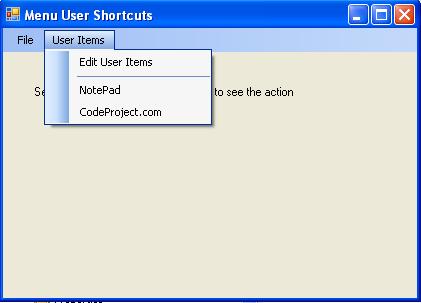
Introduction
UserMenuShortcuts is a .NET class for Windows Forms that displays a list of files or URLs in a menu. When the user clicks an item from the menu, the file/URL is launched on their machine (such as Notepad.exe or Codeproject.com). Clicked items which reference a file on the user's system will launch the item with its associated application with .NET's Process.Start() method. If the clicked item is a URL, then the user's default browser will be launched and navigate to the specified URL address.
The file that stores the user menu items is the UserShortcuts.xml file, and it is stored in the host application's directory. If a UserShortcuts.xml file is not provided/found, it will be automatically generated whenever the host application runs and cannot find the file.
Using the UserMenuShortcuts .NET Class
To use the UserMenuShortcuts in a Windows Form or another Windows .NET control, add a menu item to the form that will be replaced by the loaded menu shortcuts and then include the UserMenuShortcuts class into the project. Add the click-event handler to the placeholder menu item and then make the following method calls in your form/control class:
private void Form1_Load(object sender, EventArgs e)
{
UserShortcuts.Load(userItemsPlacehoderToolStripMenuItem,
userItemsPlacehoderToolStripMenuItem_Click);
}
private void userItemsPlacehoderToolStripMenuItem_Click(object sender, EventArgs e)
{
UserShortcuts.LaunchUserShortcutItem(sender.ToString());
}
How the UserMenuShortcuts Class Works
The UserMenuShortcuts class loads a hashtable of the menu items from the UserShortcuts.xml file and then creates a set of menu items at the same level as the placeholder menu item. The Key of each hashtable item is also used as the display text in the menu item, while the Value of the hashtable item is the target file/URL. When the menu item is clicked, a lookup of the clicked menu item's text is performed to retrieve the target file/URL, and then the target is launched with Process.Start().
public class UserShortcuts
{
...
...
private static Hashtable m_UserShortcutItems = new Hashtable();
public static Hashtable UserShortcutItems
{
get { return m_UserShortcutItems; }
set { m_UserShortcutItems = value; }
}
public static void Load(ToolStripMenuItem mniUserShortcutsPlaceholder,
EventHandler mniUserShortcutsPlaceholder_Click)
{
if (File.Exists(_Uri) == false)
{
GenerateSampleUserShortcutFile(_Uri);
}
XmlDocument _Document = null;
string sOldWorkingDirectory = Directory.GetCurrentDirectory();
try
{
Directory.SetCurrentDirectory(Path.GetDirectoryName
(Application.ExecutablePath));
_Document = new XmlDocument();
_Document.Load(_Uri);
m_UserShortcutItems = new Hashtable();
m_UserShortcutItems.Clear();
XmlNode root = _Document.DocumentElement;
XPathNavigator nav = root.CreateNavigator();
XPathNodeIterator nodeIterator = nav.Select("/UserShortcuts/UserShortcut");
while (nodeIterator.MoveNext())
{
string sMenuLabel = nodeIterator.Current.SelectSingleNode
("MenuLabel").Value.Trim();
string sShortcutPath = nodeIterator.Current.SelectSingleNode
("ShortcutPath").Value.Trim();
if (System.Uri.IsWellFormedUriString
(sShortcutPath, UriKind.Absolute) == false)
{
FileInfo fiInfo = new FileInfo(sShortcutPath);
sShortcutPath = fiInfo.FullName;
}
if (m_UserShortcutItems.ContainsKey(sMenuLabel) == false)
{
m_UserShortcutItems.Add(sMenuLabel, sShortcutPath);
}
}
LoadUserShortcutsMenu
(mniUserShortcutsPlaceholder, mniUserShortcutsPlaceholder_Click);
}
catch (Exception ex)
{
throw new Exception("Error Loading User Shortcuts", ex);
}
finally
{
Directory.SetCurrentDirectory(sOldWorkingDirectory);
}
}
private static void LoadUserShortcutsMenu
(ToolStripMenuItem mniUserShortcutsPlaceholder,
EventHandler mniUserShortcutsPlaceholder_Click)
{
if (mniUserShortcutsPlaceholder == null)
return;
int iplaceholderloc = mniUserShortcutsPlaceholder.Owner.Items.IndexOf
(mniUserShortcutsPlaceholder);
IDictionaryEnumerator iusershortcuts =
UserShortcuts.UserShortcutItems.GetEnumerator();
while (iusershortcuts.MoveNext())
{
string sMenuName = Convert.ToString(iusershortcuts.Key);
ToolStripMenuItem mni = new ToolStripMenuItem(sMenuName);
mni.Click += new EventHandler(mniUserShortcutsPlaceholder_Click);
mniUserShortcutsPlaceholder.Owner.Items.Insert(iplaceholderloc, mni);
iplaceholderloc += 1;
}
mniUserShortcutsPlaceholder.Owner.Items.Remove(mniUserShortcutsPlaceholder);
}
public static void LaunchUserShortcutItem(string sKey)
{
string sShortcutPath = Convert.ToString(UserShortcuts.UserShortcutItems[sKey]);
if ((System.Uri.IsWellFormedUriString(sShortcutPath, UriKind.Absolute) == true)
|| (File.Exists(sShortcutPath) == true))
{
ProcessStartInfo psi = new ProcessStartInfo(sShortcutPath);
psi.UseShellExecute = true;
Process.Start(psi);
}
}
}
Conclusion
I hope you find this article and class useful - it has come in handy in several applications already!
History
- 22nd November, 2006: Article posted
